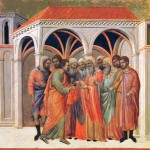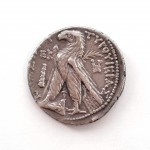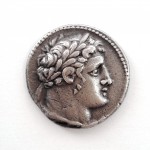Judas’s Silver Coin
«Now when Jesus was in Bethany, in the house of Simon the leper, there came unto Him a woman having an alabaster box of very precious ointment, and poured it on His head. But when His disciples saw it, they had indignation, saying, To what purpose is this waste? For this ointment might have been sold for much, and given to the poor. When Jesus understood it, He said unto them, Why trouble ye the woman? for she hath wrought a good work upon Me. For ye have the poor always with you; but Me ye have not always. For in that she hath poured this ointment on My body, she did it for My burial. Verily I say unto you, wheresoever this gospel shall be preached in the whole world, there shall also this, that this woman hath done, be told for a memorial of her. Then one of the twelve, called Judas Iscariot, went unto the chief priests, and said unto them, What will ye give me, and I will deliver Him unto you? And they covenanted with him for thirty pieces of silver. And from that time he sought opportunity to betray Him.».
(Gospel of Matthew 26:6-16)
This year in May, my numismatic collection was supplied with several objects that I brought from my trip to the Holy land; and one of such objects is a silver shekel minted in the Phoenician city of Tyre. According to the historians, these coins were the actual “pieces of silver,” for which Judas Iscariot betrayed Jesus Christ.
The place of minting: Phoenicia, Tyre. On the coin’s obverse there is an image of Melqart’s1 head wearing the laurel facing the rights side. On the reverse there is an image of an eagle with folded wings, standing on the ground facing the left side; on the left side there is also a club. The coin is made out of silver, its weight is 14.3 grams; its diameter is 29 millimeters. The coin was struck between 125(6) BC and 65(6) AD.
From the text of the New Testament it is not clear, what exact coins are called there “thirty pieces of Judas.” The monetary circulation in Judea at that time could include many coins, and among them there could be the Greek staters and tetradrachms. The attribution of the Judas’ “silver coin” to the Tyrian shekel is based on several logical reasons. First of all, the tetradrachms from the city of Tyre, otherwise known as shekels, allow to connect the text of the New Testament with the texts of the Old Testament, in particular – with the prophesy from the book of Zechariah, and with the slave, who was estimated to be worth of thirty shekels in the book of Exodus. Secondly, according to the historic evidence, the temple tax in Jerusalem was paid in Tyrian shekels, so, it is logical to conclude that the payments were made in the same currency. Thirdly, Tyrian shekels were minted throughout several hundred years and by their popularity in Judea absolutely certainly exceeded any other large silver coins. From the point of view of their value, thirty silver coins in the lifetime of Jesus was a fairly decent sum, which made a four-month salary of a skilled farming worker or of a Roman legionary, a sum, for which the Jewish high priests could even buy a piece of property close to Jerusalem.
Unlike the Old Testament, in the books of the New Testament the shekel is not mentioned a single time; but it becomes obvious that it is implied in the episode describing the miracle with a stater – because the teachers of the law in those days recommended to pay the temple tax in these very shekels. “The collectors of two-drachmas” (tax collectors, collectors of the half-shekel tax) turned to apostle Peter with a question, “Will your teacher give a two-drachma?”, that was reported to Jesus. Christ answered and said, “Go thou to the sea, and cast an hook, and take up the fish that first cometh up; and when thou hast opened his mouth, thou shalt find a piece of money [stater]: that take, and give unto them for Me and thee.” (Gospel of Matthew, chapter 17, verses 24 through 27).
Traditionally, Tyrian shekels are also identified with 30 silver coins (ancient Greek αργύρια), which Judas Iscariot received for his betrayal and which was later spend to buy the Akeldama piece of land for the burial of strangers.
Melqart1 (more accurate – Milk-qart) was one of the “young gods.” This name means “King of the City,” and the “City” there is Tyre. Melqart was very much venerated in Tyre, as he was considered to be its tutelary god; and his festal day was one of the most important holidays, or maybe the most important one in Tyre. When the Tyrians created many settlements on the shores of the Mediterranean sea, the settlers also began to worship Melqart, and in some of these settlements, as in Gades, for example, Melqart, just like in Tyre, was venerated as the city’s founder and chief god. He was also widely worshipped in the most northern Phoenician city – Arwad. And even outside Phoenicia, the king of Damascus Bar-Hadad (who lived approximately in the IX century BC) rendered worship to this god.
Phoenicians believed, that Melqart patronized distant sea voyages and colonization. Melqart was depicted as a bearded man in the pride of his years, or sometimes as a sea god riding a hippocampus, or sometimes as a hero, who was fighting with beasts, or, occasionally, monsters. These images emphasized the heroic traits of this god, which allowed Greeks to identify him with Heracles. Tyrians, instead, attributed to Melqart as their “ba’al” the creation of all things that they especially appreciated. For them, Melqart was both of the sun and of the sea.




